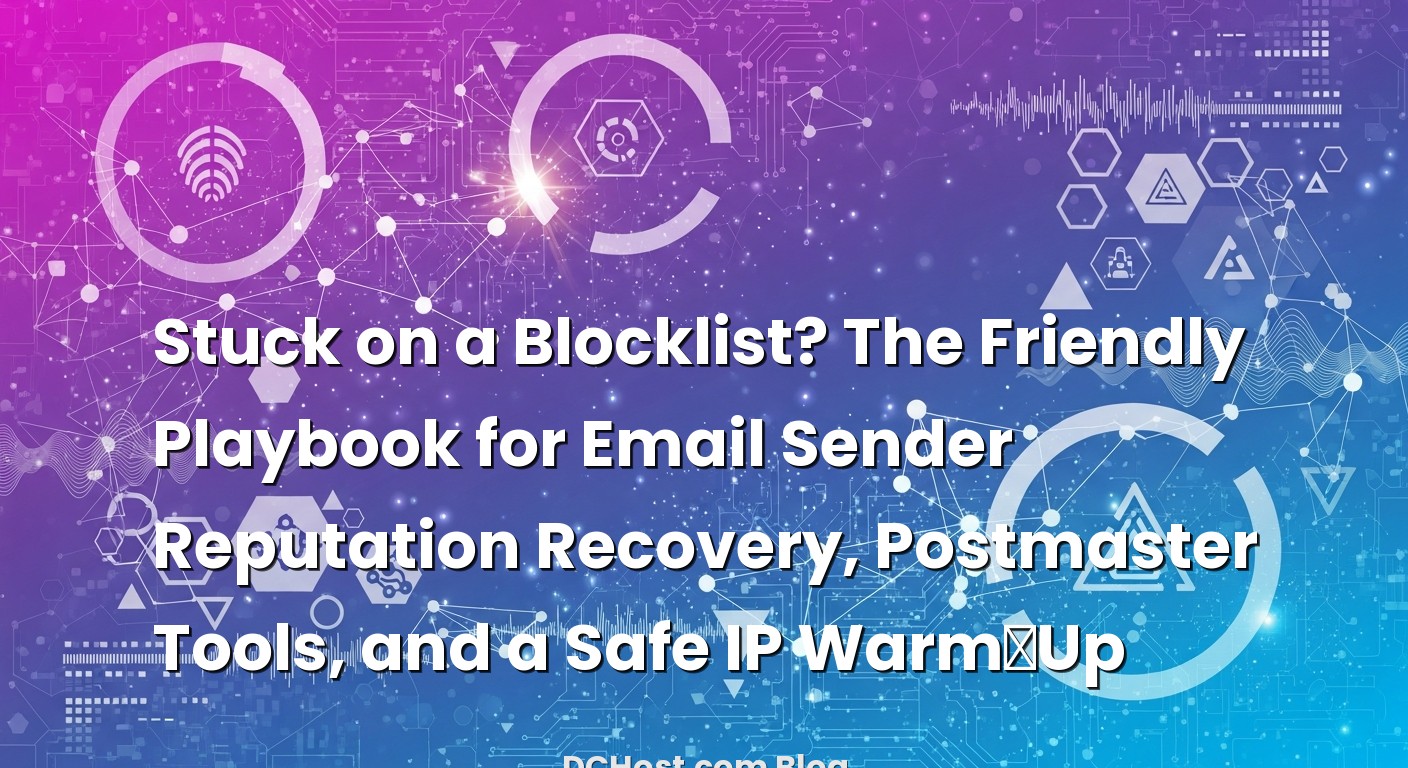İçindekiler
- 1 So, Your Emails Stopped Landing—What Now?
- 2 Understand the Reputation You Actually Have
- 3 Triage First: Stop the Bleeding, Find the Leak
- 4 Blocklists: What They Mean and How to Get Off
- 5 Postmaster Tools: Your Reputation Dashboard, Not a Report Card
- 6 Rebuilding Trust: Authentication, Data Hygiene, and Predictable Behavior
- 7 The Safe IP Warm‑Up Plan (That Won’t Get You Relisted)
- 8 Practical Playbook: Putting It All Together
- 9 A Few Friendly Extras That Punch Above Their Weight
- 10 Wrap‑Up: Your Reputation Is a Story You Write Every Send
So, Your Emails Stopped Landing—What Now?
I still remember the morning a client called me sounding like someone had unplugged the internet. “We didn’t change anything, but our emails are bouncing everywhere.” If you’ve been there, you know the feeling. Campaigns you lovingly crafted suddenly go quiet. CRM alerts pile up. Sales asks if marketing broke something. IT says the servers are fine. And yet, the inbox stays stubbornly empty.
Here’s the thing: email is more than a server pushing messages; it’s a reputation game. Mailbox providers judge your every move—how many people complain, who engages, whether your authentication lines up, and a dozen other signals you never see in your editor. When those signals go sour, you end up on blocklists, in bulk folders, or in a slow purgatory where delivery takes hours instead of seconds. The good news? You can come back from it. I’ve watched brands go from catastrophic blocklisting to “green across the board” with patience, a plan, and a little humility.
In this guide, I’ll walk you through what I do when reputations crumble: how to stop the bleeding, how to get delisted, how to read postmaster dashboards without spiraling, and how to warm up an IP safely so you don’t burn it twice. We’ll talk about the human side—what to tell your team—and the technical side—DNS, rDNS, SPF, DKIM, DMARC, and that quiet hero called list hygiene. Grab a coffee. Let’s fix this together.
Understand the Reputation You Actually Have
When your email gets cranky, it’s tempting to flip switches at random. Resist it. First, picture reputation like a credit score tied to both your domain and IP. The domain is your name; the IP is your address. Providers watch them separately and together. If your domain generally behaves but your IP is new or has a sketchy past, they’ll throttle you. If your domain starts gathering complaints—even on a shared IP—your brand takes a hit and that follows you wherever you go.
In my experience, three categories drive most reputation issues. First, engagement: are people opening and clicking, or ignoring and complaining? Second, authentication: SPF, DKIM, and DMARC need to line up cleanly with the domain you’re using to send. Third, infrastructure signals: reverse DNS that matches, a consistent HELO/EHLO name, TLS support during SMTP, and mail flows that don’t look like a robot with a caffeine problem. Think of it like showing up to a hotel: if your ID matches your face, you arrive during normal hours, and you’re not carrying a foghorn, you’re in good shape.
On the human side, your list and your promises matter. Did you switch CRMs and accidentally re‑subscribed old contacts? Did a web form get hammered by bots? Did sales upload a “friend’s list” from a trade show five years ago? None of these are villainous by themselves, but together they look like you changed your entire identity overnight. Reputation systems don’t like surprises. The cure is consistency, context, and care.
Triage First: Stop the Bleeding, Find the Leak
Before you sprint toward delisting forms, pause your risky sends. I usually freeze non‑essential campaigns for at least 24–48 hours, leaving only critical transactional mail flowing—things like sign‑ups, password resets, and receipts. If your platform doesn’t make it easy to split those streams, it’s a good moment to note that for your “lessons learned” doc. Transactional and marketing should travel on separate routes, ideally different sending IPs or subdomains, so a bad promo doesn’t strand password resets in limbo.
Next, go hunting. Start with bounce logs and feedback loops. Hard bounces tell you about list quality or typos. Soft bounces often whisper about rate limits, IP reputation, or temporary blocking. Complaint feedback loops—when you get them—are like a smoke alarm: someone clicked “this is spam.” It’s not a moral failing; it’s a data point. Remove complainers permanently and quickly, don’t argue with them in a “we’re sorry” email. That will only make your day worse.
One time, a client’s “quiet month” turned out to be a signup form that was happily accepting throwaway addresses and role accounts like info@ and sales@ all weekend. No CAPTCHA, no rate limit, no confirmation. By Monday, they’d fed a snowplow into their own list. We cleaned the form, added a double opt‑in for new subscribers, and the fog started to lift. The moral: the leak is usually somewhere obvious once you zoom in.
As you triage, check your DNS and identity basics. Make sure reverse DNS maps your sending IP to a hostname you control. Ensure your EHLO/HELO greeting matches that hostname. Confirm SPF includes the right sending services. Sign with DKIM on the same domain family you’re using in the From header. Align DMARC so the domain in the From address lines up with the domain authenticated by SPF or DKIM. None of this will fix everything, but it keeps you from looking like you borrowed a stranger’s jacket for an interview.
Blocklists: What They Mean and How to Get Off
Blocklists are like airport watchlists. Some are widely used and very influential, others are niche. Being on the big ones can suppress delivery across entire mailbox providers. Being on smaller ones can still sting, especially with gateways and enterprise filters. When you’re listed, two jobs sit in front of you: fix the root cause and write a credible delisting request. The order matters. Don’t ask for forgiveness until you’ve actually changed.
Start by confirming the listing. Look at the error messages in your bounces. You’ll often see names and codes that point you to the right place. Then go to the blocklist’s site and read their reasoning. Many provide helpful clues—spam trap hits, backscatter, open relays, or a flood of complaints. If you truly fixed the source, apply for removal using their form. For example, the Spamhaus Blocklist Removal Center is direct about why you were listed and what they expect before you ask for delisting.
When writing your appeal, be specific. “We fixed it” is weak. “We disabled the compromised SMTP credential, rotated keys, added CAPTCHA and rate limiting on the signup form, implemented double opt‑in for all new subscribers, and removed 12,431 addresses collected without consent” is much stronger. Keep it calm and factual. In my experience, the people reviewing your request can tell when you’ve actually done the work.
One more note from the trenches: be suspicious of anyone selling guaranteed delisting services. Reputation isn’t a fee you pay; it’s a behavior you change. When you fix the causes and follow instructions, most legitimate blocklists will take you off. If you get relisted fast, it usually means the leak is still open or your sending patterns still suggest spammy behavior.
Postmaster Tools: Your Reputation Dashboard, Not a Report Card
Once the immediate fire is out, go set up your dashboards. These tools don’t fix anything by themselves, but they show you whether the changes you’re making are moving the needle. The two most helpful places to start are Gmail and Microsoft.
For Gmail, verify your domain and sign up for Google Postmaster Tools. You’ll see domain and IP reputation, spam rates, authentication pass rates, and the kind of delivery errors that hint at throttling. It’s not real‑time, but it’s real enough to spot direction: are we trending toward “green,” or still hovering in “caution” land?
For Microsoft recipients (Outlook, Hotmail, and Microsoft 365), set up Microsoft’s SNDS dashboard and, if possible, their complaint feedback loop (JMRP). SNDS will tell you about spam traps, complaint volumes, and blocks by day. The combo gives you a sense of whether your repairs are sticking. Yahoo has its own postmaster ecosystem as well; even without a fancy dashboard, you can infer a lot from bounce codes and engagement patterns.
When reading these tools, think like a coach, not a judge. If your reputation is low, that’s information. If your spam rate bumps after a specific campaign, it’s a clue. If authentication dips one day, maybe something in your pipeline missed signing. In one account, we spent a full morning chasing a DKIM failure that turned out to be a staging server sending production emails without the right key; the graph told the story before anyone did.
Rebuilding Trust: Authentication, Data Hygiene, and Predictable Behavior
If you want a stable reputation, make it easy for mailbox providers to trust you. Start with authentication. SPF should include your actual senders—not a wild omnibus that invites trouble. DKIM should sign with a key you control, and the selector should be rotated responsibly. DMARC should at least be set to “none” while you gather data and move toward alignment; as you gain confidence, you can graduate to quarantine and then reject. Alignment is the keyword: the domain in your visible From address should match the domain authenticated by SPF or DKIM. That consistency is a big, quiet trust signal.
Two infrastructure odds and ends make a surprising difference. First, reverse DNS (PTR) should map your sending IP to a hostname you own, and your SMTP greeting (EHLO/HELO) should present that hostname consistently. Second, support TLS during SMTP with a certificate that matches the name you’re presenting. If you’re operating across multiple brands or subdomains, it’s worth planning certificate issuance and ownership. I like to lock down who can issue TLS certificates for your brand so someone can’t impersonate you quietly. It’s not a direct deliverability metric, but it’s part of that broader “are you who you say you are?” picture.
On the DNS side, one practical tip has saved me from weird outages more than once: keep your SPF, DKIM, and DMARC records reachable even during provider hiccups. If you’re stretching your wings with redundancy, keep your DNS authentication records highly available so a single bad DNS day doesn’t look like you turned off signing.
Now, the messy bit: data hygiene. I can’t overstate this—your list is your reputation. If you don’t know exactly how an address got in, treat it like a stranger at your front door. When you’re recovering, lean hard into confirmed opt‑in for new subscribers. Sunset unengaged contacts gracefully and earlier than you’re comfortable with. If someone hasn’t opened in months, don’t keep poking; you’re teaching mailbox providers that your mail can be ignored. Run a re‑permission campaign once, explain what’s changing and why, and don’t send again if they don’t raise a hand.
One client kept their list “alive” by emailing everyone quarterly. That sounds harmless until you realize the quarterly sends produced the highest complaint spike of the year, every year. We changed the policy to keep a heartbeat going with genuinely interested people and decided that silence is a decision. Complaints dropped; engagement climbed. The best way to be treated like a friend is to act like one—don’t shout at people who aren’t listening.
A final note on brand and domain strategy. If you’re sending from multiple subdomains—like newsletter.example.com and receipts.example.com—be intentional. Keep transactional and marketing streams separate to protect critical messages. And think ahead about your domain story. If you’re curious how to build the bigger naming plan around that, I’ve shared how to set a thoughtful domain strategy without the panic. That plan tends to pay off in email reputation because consistency breeds trust.
If you’re running a multi‑tenant product or handling lots of domains at scale, automated TLS and predictable identity help you look legit at every hop. The patterns from the web world apply nicely here too—I’ve written about how to scale automatic TLS across many domains in a way that keeps your name clean and your tenants happy. Email isn’t identical to HTTP, of course, but operational hygiene rhymes across protocols.
The Safe IP Warm‑Up Plan (That Won’t Get You Relisted)
Warming up an IP is like introducing yourself to a neighborhood. If you show up quietly, meet a few people each day, and keep your promises, you’ll be welcome. If you blast a foghorn on day one, someone calls the cops. The trick is to start small with people who actually want to hear from you, and then expand slowly and predictably.
Here’s how I usually do it. First, choose your stream carefully. Warm up on a single dedicated IP with consistent content. Don’t mix transactional and promotional during the early days. If you can, use a subdomain that clearly signals its purpose, like news.example.com for newsletters. Make sure SPF/DKIM/DMARC are fully aligned on that identity before you send a single message.
Then, pick your friendliest audience. Start with your most engaged subscribers—people who opened or clicked in the last couple of weeks. This is your warm‑welcome crew. Send them something valuable and expected: a weekly digest, a product tip they signed up for, or a time‑sensitive update they chose. Keep the content consistent over the first days; changing your tone or template dramatically mid‑warm‑up confuses the signals you’re trying to teach.
Increase volume gradually. I avoid rigid charts in public posts because schedules vary wildly, but the spirit is steady. If day one is a few hundred to a couple of thousand highly engaged recipients, day two is a little more to the same pattern, not ten times more to a cold segment. Watch results after each send: bounces, spam complaints, open rates. If soft bounces or complaints flare up, slow down before the providers slow you down. Rest days help, too. When things look edgy, take a breath, fix what needs fixing, then resume at the last safe level.
Concurrency matters as much as volume. Don’t open the fire hose and send everything in five minutes. Throttle connections, spread bursts over time, and respect provider guidance if your platform supports per‑destination rate limits. You want deliverability to feel like a calm Tuesday afternoon, not a flash sale panic.
Beware of list sources during warm‑up. This is not the time to import a dusty CSV or test an “acquired” list. Stick to subscribers who explicitly opted in and who interacted recently. I once watched a marketing team turn a perfect three‑day trend into a cautionary tale by adding a “VIP list” that hadn’t heard from them in two years. The graph went from green to gray in an hour. We paused, ran a re‑permission prompt to that cohort on a separate, lower‑risk stream, and rebuilt, but it cost us two weeks.
Finally, measure what matters. During warm‑up, success isn’t a massive open rate; it’s a stable pattern of low complaints, clean authentication, and predictable delivery. Use your postmaster dashboards as a compass, not an obsession. If Gmail’s domain reputation nudges upward and Microsoft’s SNDS stays quiet, you’re doing it right.
Practical Playbook: Putting It All Together
Let me stitch the steps into a single flow you can run today. First, pause non‑essential mail and separate transactional from promotional. Second, fix root causes: secure your forms, enforce double opt‑in for new signups, remove obvious bad addresses, and process bounces and complaints immediately. Third, tighten identity: align SPF, DKIM, DMARC; match your rDNS and EHLO; and support TLS cleanly.
Then, identify specific blocklists from bounce data, read their reasoning, and ask for delisting only after your fixes are live. Write your appeals like a change log—clear steps, clear timelines, and clear ownership. In parallel, bring your dashboards online. Postmaster tools will show whether your improvements actually improve things. Every day, look for trends, not just peaks: fewer soft bounces, fewer complaints, and steadier inbox placement across your seed checks or test accounts.
When the smoke clears, warm up deliberately. Start with your happiest subscribers, ramp slowly, and keep content consistent and expected. If the graph wobbles, step back a notch. It’s okay to take longer and land safely. And when you’re out of the woods, keep the habits: sunset unengaged users, rotate DKIM keys on a sensible schedule, audit your web forms quarterly, and document your sending streams. Play the long game. Reputation loves routine.
A Few Friendly Extras That Punch Above Their Weight
Two final ideas that have helped me keep reputations tidy over the long haul. First, keep an internal seed list made of real, monitored inboxes across major providers. Don’t obsess over one message, but track trends. Where did it land? How fast? Did the images load? This helps you catch oddities—like a template change that breaks your DKIM header—before customers do.
Second, talk to your brand and domain folks. If your company is expanding internationally or launching new sub‑brands, email needs a seat at that table. Don’t end up sending newsletters from a domain policy that was designed only for the website. Coordinating across teams makes the entire identity story cleaner. If you’re building that broader plan, I’ve shared thoughts on controlling certificate issuance with CAA records and choosing domains thoughtfully, and if you run multi‑tenant systems, the playbook for automatic TLS at scale is surprisingly relevant to keeping a clean, consistent identity in email, too.
Wrap‑Up: Your Reputation Is a Story You Write Every Send
If you’re stuck on a blocklist right now, take a breath. It feels personal because you put so much into your messages, but reputation is just math watching patterns. Change the pattern, and the math follows. Stop the risky sends. Fix the leak in your list. Align your identity so everything says the same name out loud. Ask for delisting with specifics after you change, not before. Then warm up slowly with people who like hearing from you, and keep your eye on the dashboards rather than the comments from the next room.
In my experience, the teams that bounce back fastest are the ones that own the story. They document what happened without blame, they fix what’s broken without shortcuts, and they keep the habits that prevent a relapse. That’s it. No magic incantations, just steady craft. If this helped, I’m glad. And if you’re in the thick of it and want a sanity check on your plan, I’ve been there. Keep going—the inbox will open up again. See you in the next post.





